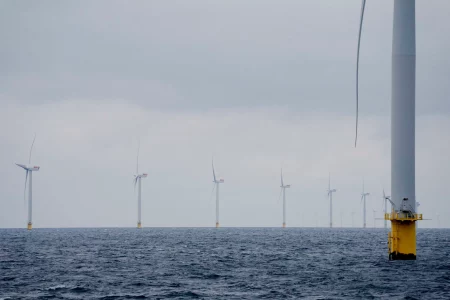This website uses cookies to improve your experience. We'll assume you're ok with this, but you can opt-out if you wish. Read more
Can the north winds power Europe?
Can the north winds power Europe?
Like the rest of the world, Denmark could use some good news for a change. For the second year in a row, the country ranked first on the Environmental Performance Index, a leading measure of sustainability (the US came in at number 43 out of the 180 countries surveyed). As evidence of its environmental ambitions, Denmark recently hosted two agreements to increase green energy production in northern Europe. The initiatives are supposed to reduce Europe’s dependence on Russian oil and gas and to transition to clean energy sources.

The future seaview on either side of DK.Photo: Bo Amstrup/© Ritzau Scanpix.
During the summer, the country joined Germany, the Netherlands, and Belgium in the Esbjerg Declaration (DK) on building out wind turbines in the North Sea. Esbjerg is Denmark’s main port on the west coast of Jutland. The plan calls for the creation of infrastructure to supply 150 gigawatts of electricity by 2050. That is six times as much as the entire world’s current offshore wind power capacity. It would equal the output of 10,000 of the largest wind turbines and deliver electricity to 230 million European households. The Declaration was announced at the Esbjerg plant of Vestas Wind Systems. The Danish firm is the world’s largest wind turbine producer.
Putin spurs green conversion
At the end of August, Denmark signed a similar agreement with seven other countries to the East to set up wind turbines in the Baltic Sea. According to the Marienborg Declaration (named after the Danish prime minister’s residence), the effort will increase the wind power generated from the current 2.8 gigawatts to 20 gigawatts by 2030. Denmark’s contribution will be 3 gigawatts of capacity off the island of Bornholm, some of it to be channeled to Germany.
“Putin’s attempt to blackmail us with fossil fuels is failing,” said Ursula van der Leyen, European Commission President, who also attended the meeting. Earlier this year, the Commission announced that it wanted to reduce consumption of Russian gas by two-thirds this year and completely by 2030. The EU also set targets of reducing greenhouse gases by 55% by 2030 and becoming carbon-neutral by 2050, when the Baltic Sea offshore production has the potential to reach 93 gigawatts.
The N-word redux
That all sounds good, but few targets for reducing fossil fuel use and GHG emissions have been met on time. The Municipality of Copenhagen just abandoned its goal of becoming carbon-neutral by 2025. Wind is of course an intermittent energy source, and some nations are adjusting their outlook for renewable sources. Last year the EU made a controversial decision to categorize natural gas and nuclear power as sustainable energy sources, at least during a transitional period until renewables become more widely available. France, the region’s largest nuclear power producer, is increasing its capacity. Germany is reconsidering its decision to close its last two reactors, and the Swedish government wants to develop additional capacity.
The EU decision also revived the debate in Denmark. Two local researchers are among those who doubt that the world can reach its climate goals without more nuclear power (DK). Bent Lauritzen of the Technical University of Denmark and Kirsten Halsnæs, a coauthor of the UN IPCC’s comprehensive 2018 report (DK), argue not only that nuclear is the most reliable non-fossil energy source but also that new technology makes accidents very unlikely and waste disposal practical. According to World In Data, nuclear is both as sale and as clean as both wind and solar. The local detractors, on the other hand, cite, in addition to the usual safety fears, the high cost of building facilities (DK), the long time required to build them, the lack of regulatory competence, and people’s fears of its proximity.
NIMBY or status quo bias
The prospect of nuclear faces stiff resistance in Danish Parliament. Minister for Climate, Energy and Utilities Dan Jørgensen rejects the option completely. Denmark passed a law banning nuclear power production in 1985 and shut down the last of its three reactors in 2001. In the 1970s and 1980s, Danes demonstrated against Sweden’s Barsebäck plant (DK), which lay only 20 kilometers from Copenhagen and was eventually closed in 2005. In 2019, Parliament voted to reduce its support for the EU nuclear power program (DK). Last year, when a small right-wing faction proposed that nuclear be included in the government’s energy planning, the motion was defeated 88-11 (DK).
But public sentiment has shifted (DK) somewhat since Russia’s invasion of Ukraine. Proponents of nuclear power, including a majority of younger adults, now almost equal the number opposed (36 percent vs. 40 percent), and a similar plurality (38 percent to 33 percent) doesn’t believe that Denmark can reach its climate goals without nuclear. This month a citizen’s proposal (DK) to build new reactors was submitted to Parliament.
The country’s commitment to wind and lingering antipathy toward nuclear might be hindering the diversification of its sources, but a hard winter without Russian fuel could begin to test people’s patience with environmentalists’ outworn scruples.


